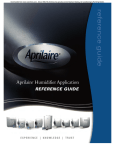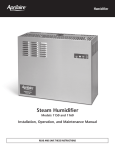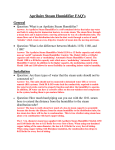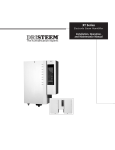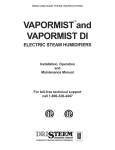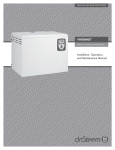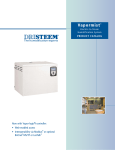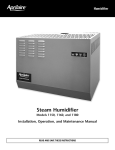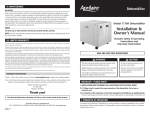Download Aprilaire 800 Troubleshooting guide
Transcript
Aprilaire Model 800 Steam Humidifier FAQs General Q: What is the Model 800 Aprilaire Steam Humidifier? A: The Aprilaire Model 800 Steam Humidifier is a self-contained device that takes tap water and boils it, using electrode technology, to create steam. The humidifier generates steam by energizing two electrodes that extend into a canister of water. Current flowing between the electrodes causes the water to boil, creating steam. The steam flows through a steam hose and is injected into a moving airstream by the way of a distribution tube. The steam flows out of the distribution tube into the duct work through a series of small “tubelets” which create an even, drip-free transfer of steam into the moving airstream. Using Dri-Steem’s (who is the world’s leading expert on steam) dispersion tube and “tubelet” technology, only the hottest, driest steam is introduced into the duct. Installation Q: Are there types of water that the steam unit should not be connected to? A: Yes. The unit should not be connected to deionized water (DI) or reverse osmosis (RO) systems. Both DI and RO water lack enough conductivity required for the humidifier to operate properly. In addition, DI water can have a corrosive effect on the non-stainless steel components in the system, leading them to premature failure. Q: Why must the unit be connected to cold water? A: The humidifier uses the cold water to temper the boiling water as is it drains. Adding cold water as the unit drains allows the unit to drain immediately without a cool down period or the use of a high temperature condensate pump. Q: How much hard piping can you use with the 6 ft. steam hose to extend the distance from the humidifier to the steam distribution tube? A: The maximum recommended length of steam hose is 6 ft. and maximum recommended length of 1” insulated copper is 20 ft. The capacity of the humidifier is reduced by the length of the steam hose or hard pipe due to condensation. The distance between the steam humidifier and the dispersion tube should be as short as possible. Refer to the steam humidifier capacity chart in the installation instructions. Q: Will standard 1” copper fit inside of the 6 ft. steam hose? A: 1” copper doesn’t easily fit inside of the steam hose, so we recommend using a standard ¾” to 1” copper adapter. The ¾” end of the adapter fits inside of the steam hose and can be secured with a hose clamp. The 1” side of the adapter will need to be soldered to the 1” copper pipe. Q: Do the steam hose and distribution tube have to be sloped back towards the humidifier? A: Preferred method would be to have the steam hose and/or tubing with a minimum pitch of 2”/ft. from the distribution tube back to the humidifier to allow for condensation within the tube to fall back into the steam canister. If the application configuration does not allow for this, a drip tee, P-trap, and drain must be installed at the steam distribution tube and hose connection point. P-trap must be primed. Refer to the installation instructions for more detailed information. Q: Why does the steam capacity increase as the voltage increases, but the amp draw stay the same? A: By increasing the voltage, you are increasing the power to the unit. P= V*A. Power or watts (kilowatts) is what causes the water to steam. More power, more steam. The 800's software controls the amps through the unit, so increasing voltage increases power with constant amps. Q: Are steam humidifiers expensive to operate? A: Steam is more expensive than evaporative, because steam humidifiers heat the water to boiling to generate steam, while evaporative humidifiers use heat from the HVAC equipment or hot water to evaporate water. All residential steam humidifiers use generally the same amount of electricity. Residential steam humidifiers on average cost 10 cents per hour to operate. Q: What is the recommended minimum distance for installing the steam tube from components, such as the coil, filter, blower, dampers, etc.? A: The absorption distance will vary depending upon the air velocity. If you have 28” of unobstructed duct with 300 fpm velocity, the steam will be absorbed into the air. If you have less than 28”, refer to the installation instructions or call Aprilaire technical support. Q: Can duct board or flex duct be used in conjunction with the Aprilaire steam humidifier? A: In order to support the weight of the steam distribution tube and steam hose, the distribution tube must be installed in a solid section of the metal ductwork; however, if absorption distance requirements have been met, there is no reason duct board flex duct could not be used in either the supply or return branches. Unit Operation Q: How much water is in the steam canister? A: The software in the Model 800 controls the amount of current through the water by raising and lowering the water levels (increasing and decreasing the amount of electrode covered). The amount the electrodes are covered will vary with canister life and conductivity of the water. The maximum amount it can hold before it reaches the high water level probe is 80 ounces (2 -1/2 quarts). Q: How long does it take the unit to fill the steam chamber and bring the water to boil? A: The time it takes a canister to boil depends upon water conductivity, voltage and life of canister. During initial start up, the canister can take an hour to reach maximum capacity. The reason for this is it may need to increase conductivity of the water by boiling the water to increase the mineral content. Once proper conductivity of the water is reached, the canister will reach capacity within minutes. Unlike resistive units which require all the water in the canister to reach boiling, a steam unit boils water around the conductive path; thus, quicker response. Higher voltages also reduce time to capacity due to the increased power available. Q: How often does the unit drain? A: If the humidifier has operated 168 hours without a drain cycle, the drain valve will open and drain the canister. If the humidifier doesn’t receive a call to operate in 72 hours “end of season,” the controller drains the canister. The humidifier will resume normal operation when a steam call is made. Q: How much water is used for steam vs. drain? A: 80% if the water that a steam humidifier uses is turned into steam; 20% is drained. This is opposite of an evaporative humidifier; 80% is drained and 20% is evaporated. Q: What are the power requirements for the humidifier? A: Humidifier draws 11.5 amps +/- 10%. Use 12.7 amps when sizing circuit. Q: What is the weight of the humidifier? A: The shipping weight of the unit is 20 lbs. and the operating weight is 23 lbs. Q: How does the canister seal inside of the humidifier and is there any leak protection? A: The steam hose connects to the top of the canister and is secured with a hose clamp. The bottom of the canister inserts into the drain assembly and seats against an o-ring creating a seal. The unit also has a large internal drain pan for overflow and leak protection. Replacement canisters (Part Number 80) come with a new o-ring and are sold 6 per carton or 108 per pallet. Q: Can the humidifier be installed where there isn’t any forced air system? A: Yes. AA will be launching a fan pack (Part Number 850) in October of 2010. This can be remotely mounted and will dispense humidity into the living space. Q: There was a pungent smell coming from the steam hose the first time the unit was started up. Is this normal? A: When the rubber in the steam hose is heated up the first time, an odor may be present for about 15-30 minutes. This will only occur during the initial period of operation. Q: Can foaming be an issue with the humidifier? A: If the steam hose and distribution tube that come with the unit are used, foaming should not occur. Using a different hose or hard piping that may contain residue, foaming could occur. If foaming is detected, you will need to rinse the canister and steam hose. The canister o-ring should only be lubricated with water. Automatic Digital Steam Humidifier Control Operation Q: Can the Automatic Digital Steam Humidifier Control be used to control more than one Aprilaire Steam Humidifier? A: If multiple humidifiers are attached to the same furnace, they can be controlled by a single humidistat. If each unit is installed on separate HVAC systems, they will need to be controlled separately. Need a diagram from engineering. Q: If used in conjunction with the Aprilaire Model 8570 thermostat, will the humidity level be displayed? A: Yes. If the serial output (ZA & ZB) from the Automatic Digital Steam Humidifier Control is connected to the corresponding terminals on the Aprilaire 8570 thermostat, the thermostat will display the indoor relative humidity. In addition, it will display the outdoor temperature, assuming the outdoor temperature sensor is connected to the Humidifier Control. Note that the indoor humidity will only be displayed on the 8570 when the blower is running. Q: Can the Model 8870 Communicating Thermostat be used to control Aprilaire Steam Humidifiers? A: Yes, the Model 8870 can be used with the Model 800; the Model 8870 can provide a dry contact to turn the humidifier on/off. Q: Can the unit be operated based on a third party control? A: Yes. Any control that can provide a dry contact will turn the humidifier on and off. Q: What is “on/off” versus “modulation”? A: The Model 62 uses an on/off control that tells the steam humidifier to either be “full on” or “off”. The Model 800 does not modulate. Modulating controls are used with large steam humidifiers to control tight set points. This is beneficial with large capacity steam humidifiers in commercial applications. Modulation is not critical in residential applications where the humidity is used for comfort. The benefit of modulation cannot be perceived by the homeowner. Disadvantage to modulation is noise. As the humidity level gets closer to set point, the humidifier will turn on and off repeatedly until set point is reached. Q: What is the humidity operating range of the Automatic Digital Steam Humidifier Control? A: 10% to 45% RH. When the Automatic Digital Steam Humidifier Control is installed with the outdoor sensor, the control will automatically adjust the set point up and down as the outdoor temperature changes. The control is trying to provide as much humidity as possible without condensation forming on the windows and walls. If the control is installed in the manual mode, the homeowner will need to make all the adjustments. Q: When installed in the automatic mode, does the Automatic Digital Steam Humidifier Control turn off when the outdoor temperature is above a certain temperature? A: Yes. When the Automatic Digital Steam Humidifier Control is installed in the automatic mode, the humidifier will not operate if the outdoor temperature is above 60°F. Q: What options are available to protect the HVAC system from excessive humidity? A: The Model 62 Automatic Steam Humidifier Control will not allow the humidifier to run until the HVAC system running, so excessive humidity should not be an issue. If the application warrants the use of a safety device, the Part Number 4592 Air Flow Proving and the Part Number 4594 High Humidity Limit Switch are available. For wiring diagrams, see the installation instructions that come with the parts. Q: Does the furnace or furnace fan need to be on before the humidifier will run? A: Yes, the humidifier can’t run until air is moving through the ducts. The Model 62 Automatic Steam Humidifier Control has a built in blower activation relay. When the blower activation relay switch is set to the “on” position, the control will automatically turn on the furnace fan after one hour without a fan call to sample the humidity level of the air. If the humidity level is below the set point, the humidifier will turn on and run until the set point is reached. Maintenance Q: What kind and frequency of maintenance is required? A: Replace the canister annually and when prompted by the “service” light. Use only a genuine Aprilaire Model 80 canister. Inspect the drain line to make sure it is not blocked and has constant downward slope. If water flow from the fill valve is restricted, turn off the water, disconnect the inlet fitting and remove the in-line strainer. Clean or replace strainer. Display Panel Lights On/off - Solid green light when the humidifier is on - Flashes green for one minute once power is restored if humidifier was operating when power was shut off Fill - Solid green when water is being added to the canister - Flashes green (along with drain light) indicating fill and drain valves are pulsing to dislodge mineral deposits - Solid red if unit is calling for water, but no water is detected Steam - Solid green during a call for humidity - Solid yellow if humidifier can’t reach nominal output within first 48 hours Drain - Solid green to indicate start of drain cycle - Flashes green (along with fill light) indicating drain and fill valves are pulsing to dislodge mineral deposits - Flashes green indicating canister is draining Service - Flashes red when canister cannot generate steam, because the electrodes have been coated with mineral deposits and the canister needs to be replaced - Flashes red when the water conductivity is low after 96 hours of run time; add 1/10 teaspoon of salt - Solid red if controller detects over-current between the electrodes. See troubleshooting guide. F.Y.I. Weight of water One gallon of water is comprised of 8 pints 1 pint of water weighs 1.043 pounds 1 gallon of water weighs 8.3 pounds Model 800 conversions 120 volt capacity is 11.5 GPD 120 volt capacity is 92 pints per day (11.5 x 8) 92 pints = 95.96 pounds 120 volt capacity = 3.998 pounds of steam per hour (95.96 / 24 hrs) 240 volt capacity is 23.3 GPD 240 volt capacity is 186.4 pints per day (23.3 x 8) 190 pints = 194.4 pounds 240 volt capacity = 8.1 pounds of steam per hour (194.4 / 24 hrs) Water hardness formula Water is generally measured in grains of “hardness” 1 grain is equivalent to 64.8 milligrams of material Grains of hardness are usually referring to “calcium carbonate and or magnesium” content The Siemens is the unit for electrical conductance. Conductance is the reciprocal of the resistance, so if something has a resistance of 100 ohms, it has a conductance of 1/100 Siemens = 0.01 Siemens. This same unit used to be called the mho (which is ohm, the unit of resistance, spelled backwards), but that unit is no longer preferred. A micro Siemens is simply 1 millionth of a Siemens. Our Model 800 operates on a very wide range of conductivity (250 – 1250 micro Siemens). Hard Water in the United States More than 85% of American homes have hard water. The softest waters occur in parts of the New England, South Atlantic-Gulf, Pacific Northwest, and Hawaii regions. Moderately hard waters are common in many of the rivers of the Tennessee, Great Lakes, Pacific Northwest, and Alaska regions. Hard and very hard waters are found in some of the streams in most of the regions throughout the country. Hardest waters (greater than 1,000 ppm) are in streams in Texas, New Mexico, Kansas, Arizona, and southern California. Very soft: 0-70 ppm 0-4 GH Soft: 70-140 ppm 4-8 GH Slightly hard: 140-210 ppm 8-12 GH Moderately hard: 210-320 ppm 12-18 GH Hard: 320-530 ppm 18-30 GH Very hard: >530 ppm >30 GH Our Model 800 operates on a range of 3 – 35 GH. Remember a family of 4 will add @ 2 gallons of humidity per day through everyday activities like breathing, cooking, bathing and washing.









